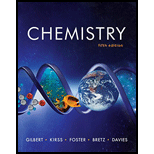
Interpretation: The reason corresponding to the fact that the boiling point of  is lower than that of iodine monochloride,
is lower than that of iodine monochloride,  even though they have nearly same molar mass are to be stated.
even though they have nearly same molar mass are to be stated.
Concept introduction: The intermolecular interaction between non-polar or least polar molecules is known as dispersion force. This is also known as, London force in honor of the Fritz London’s great work on it. Boiling point of a compound is defined as the temperature at which the compounds start boiling. At this temperature the bonds present within the molecules start weakens and hence, liquid converts to the gaseous form.
To determine: The reason corresponding to the fact that the boiling point of  is lower than that of iodine monochloride,
is lower than that of iodine monochloride,  even though they have nearly same molar mass.
even though they have nearly same molar mass.
Want to see the full answer?
Check out a sample textbook solution
Chapter 10 Solutions
Chemistry: The Science in Context (Fifth Edition)
 ChemistryChemistryISBN:9781305957404Author:Steven S. Zumdahl, Susan A. Zumdahl, Donald J. DeCostePublisher:Cengage Learning
ChemistryChemistryISBN:9781305957404Author:Steven S. Zumdahl, Susan A. Zumdahl, Donald J. DeCostePublisher:Cengage Learning ChemistryChemistryISBN:9781259911156Author:Raymond Chang Dr., Jason Overby ProfessorPublisher:McGraw-Hill Education
ChemistryChemistryISBN:9781259911156Author:Raymond Chang Dr., Jason Overby ProfessorPublisher:McGraw-Hill Education Principles of Instrumental AnalysisChemistryISBN:9781305577213Author:Douglas A. Skoog, F. James Holler, Stanley R. CrouchPublisher:Cengage Learning
Principles of Instrumental AnalysisChemistryISBN:9781305577213Author:Douglas A. Skoog, F. James Holler, Stanley R. CrouchPublisher:Cengage Learning Organic ChemistryChemistryISBN:9780078021558Author:Janice Gorzynski Smith Dr.Publisher:McGraw-Hill Education
Organic ChemistryChemistryISBN:9780078021558Author:Janice Gorzynski Smith Dr.Publisher:McGraw-Hill Education Chemistry: Principles and ReactionsChemistryISBN:9781305079373Author:William L. Masterton, Cecile N. HurleyPublisher:Cengage Learning
Chemistry: Principles and ReactionsChemistryISBN:9781305079373Author:William L. Masterton, Cecile N. HurleyPublisher:Cengage Learning Elementary Principles of Chemical Processes, Bind...ChemistryISBN:9781118431221Author:Richard M. Felder, Ronald W. Rousseau, Lisa G. BullardPublisher:WILEY
Elementary Principles of Chemical Processes, Bind...ChemistryISBN:9781118431221Author:Richard M. Felder, Ronald W. Rousseau, Lisa G. BullardPublisher:WILEY





